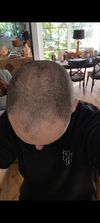community 18 Months progress, age 32 years , 3 x fin per week, 1x min daily, 1-2 times per week vitamin D and once every 2 weeks nizoral shampoo
The user shared their 18-month hair loss treatment progress, using finasteride three times a week, daily minoxidil, weekly vitamin D, and bi-weekly nizoral shampoo. They experienced initial shedding and greying, but are satisfied with the results.
